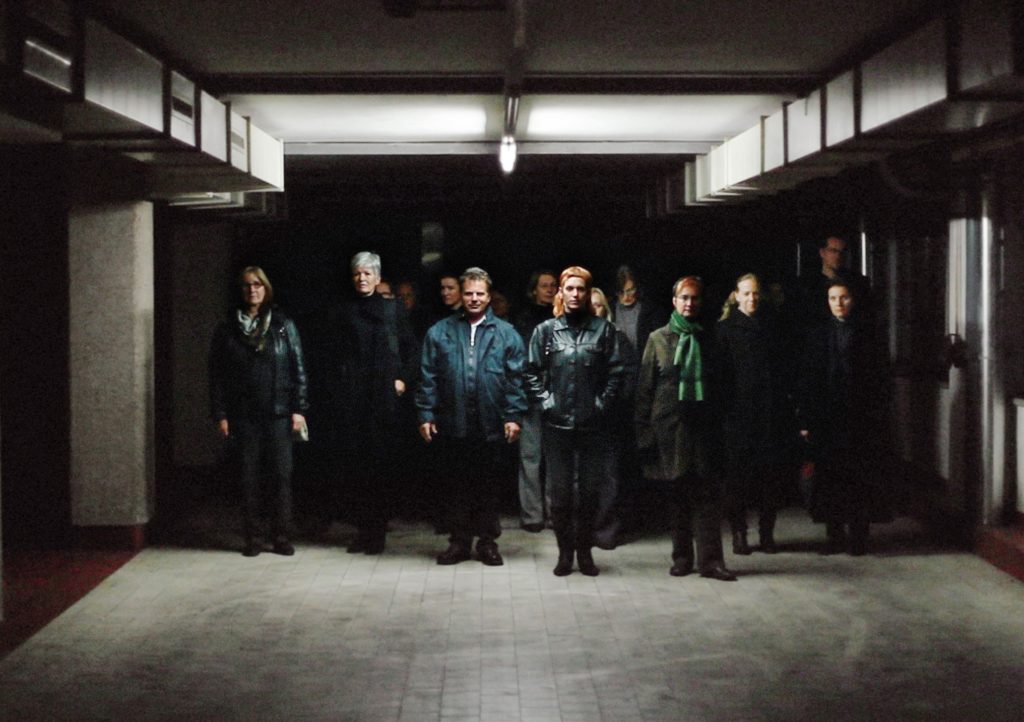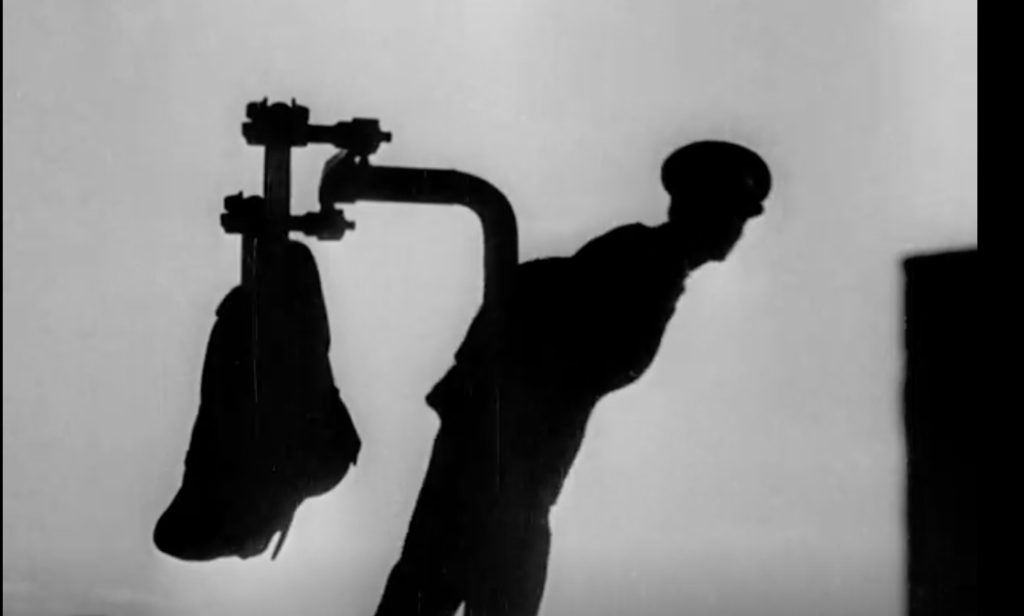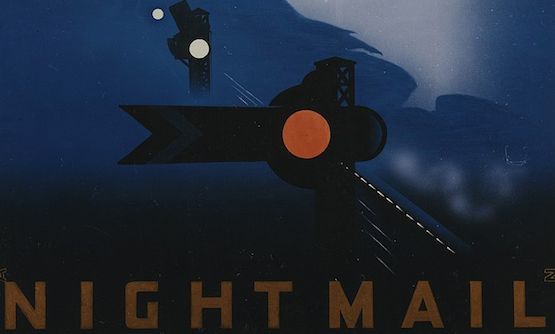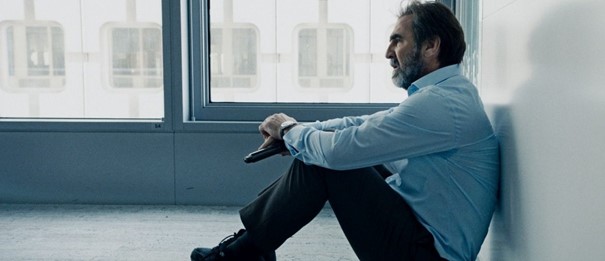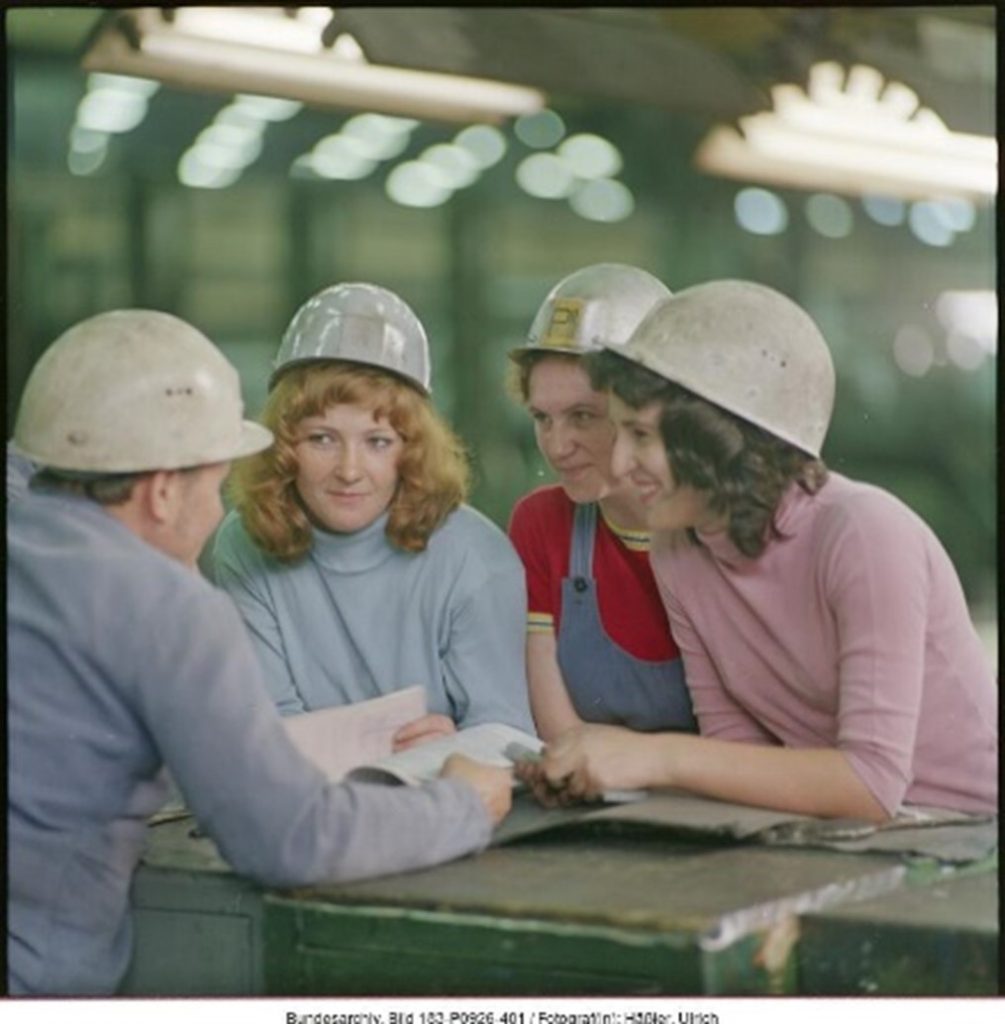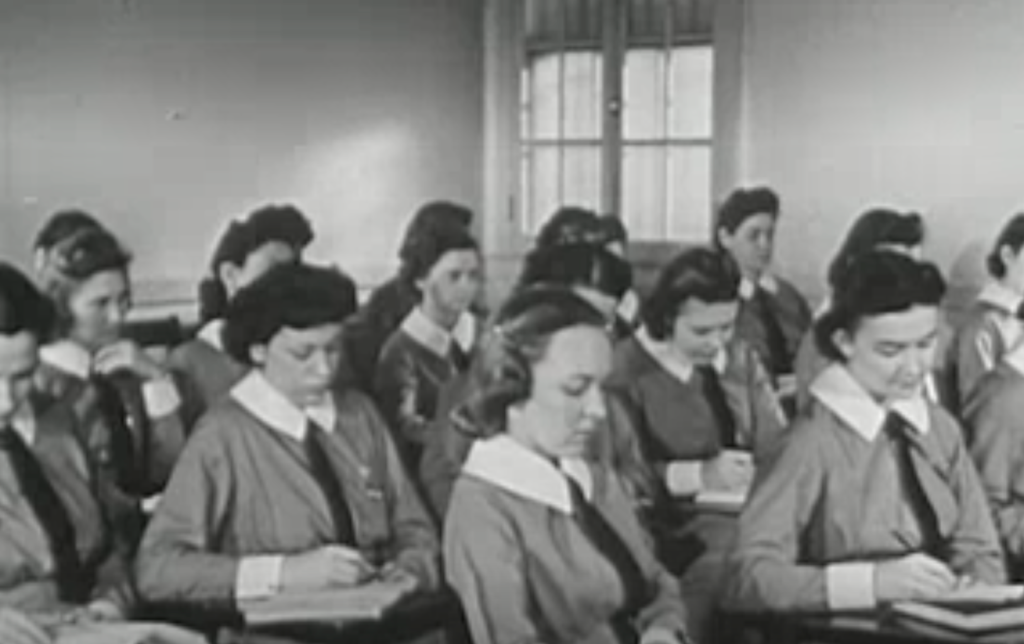Unfiltered working realities. The apprenticeship of a skilled canner
On the basis of four snippets, we would like to point out decisive characteristics of vocational guidance films in the 1960s. It is of central importance that the example in question deals with an industrial occupation, so it is set in an industrial environment and testifies to the Fordist-Taylorist concept of production at that time. The assembly line appears as the dominant moment that determines the work process, where apprentices appear as cogs in the machine that should be “assembled” as efficiently as possible (*).
Apprentices and factory staff look attentively at the running assembly line (shots 4–17, 0:50). The apprentices’ forebodingly stern facial expressions seem to express the seriousness of the situation. The apprentices are shown in close-up and half-total, the shots of the assembly line are also mainly close-up detailed shots. The apprentices are shown en masse, there is still no noticeable tendency towards individualisation, as the assembly line, the change of shot size and duration create the impression a dynamism.
On the one hand we see a static training situation with a close-up of the trainer, which emphasises the seriousness of what is being said, and on the other hand we see close-ups of the conveyor belt and short tracking shots during the lecture in order to loosen up the performance. The master (shot 18, 1:20) embodies authority and importance and provides rather comprehensive information (usefulness of multiple skills, areas of employment in the company, possible careers, etc.). Work virtues or skills are not elaborated on, but are summarised with the expression “be capable”. In part, this may be due to a lack of work analyses and a lack of an inventory of terms. However, there is a noticeable “narrowness” in the presentation of career paths. The subtext here could be, “You’re going to be industrial workers and you’re going to stay that way, get over it, you’ll make a living and it’s good for the company.”
Cut to the jam kitchen, the atmosphere of a commercial kitchen (shots 22–28, 1:59), the cooking vat for mixing jam in semi-close-up shot, then zoom in on the surface of the jam mix. The comment of the foreman: “It’s just like mother’s” — seems appeasing and almost touching due to the obvious discrepancy to the visual representation.
In the depiction of the industrial production, there is a clear difference to today‘s images of the world of work. The jam sticks to the production line (min 2:20), the sauerkraut hangs in shreds on machine parts (min 1:07). Such aestheticisation of labour or aesthetic capitalism as thematised by Andreas Reckwitz and Gernot Böhme is reserved for post-Fordism.
In short: The film seems dynamic and almost immersive because of the rhythm set by the machinery and the assembly line. The effectively staged production becomes the “ticking clock” and in actuality the “main actor”. The constriction and over-dependency of the labour force that this conveys may be jarring from today’s perspective, but it is an unavoidable feature of the production regime of that time. The most striking difference to today concerns the objective representation of reality: no embellishment is aimed for, only the visualisation of functionality dominates. Likewise, individualisation is obviously not yet a characteristic of vocational guidance films. In terms of film composition, however, there are hardly any differences to contemporary filmmaking of this type.
Canners became “canners and freezers” in 1970, “canner and freezer technologists” in 1983, and these finally became our “food technologists” of today. The transformation and aestheticisation of the training occupation are thus also reflected in the evolution of job titles. Obviously, we have kept up tending to polish up the terminology and representation of the world of work for quite some time, while “keeping up with Kardashians”.
Dr. Reinhold Gaubitsch is a political scientist and was, until his retirement, project manager in the Department of Labor Market and Career Information of the Public Employment Service Austria and responsible, among other things, for vocational guidance films.
(*) In her historical discourse analysis, Lena Freidorfer uses 600 newspaper articles to describe the changes in the image of apprentices in the cantons of German-speaking Switzerland between 1950 and 1970: from the conformist “production factor” (1950–1959) to the apprentice in need of protection (1960 — 1967) to the protesting apprentice (from 1968). What can be seen in the film is certainly a mixture of the first two with an emphasis on the ‘production factor’.
References:
Böhme, Gernot (2016). Ästhetischer Kapitalismus, Berlin: Suhrkamp.
Freidorfer-Kabashi, L. (2020): Vom „Lehrling“ zum „Lernenden “ – Zur Wahrnehmung Jugendlicher in Ausbildung im Zuge der Transformation der beruflichen Bildung [From “apprentice” to “learner” — The perception of young people in training during the transformation of vocational education and training]. In: bwp@ Berufs- und Wirtschaftspädagogik – online, Ausgabe 38, 1–34. Online: https://www.bwpat.de/ausgabe38/freidorfer-kabashi_bwpat38.pdf (24.06.2020).
Reckwitz, Andreas (2008). Elemente einer Soziologie des Ästhetischen, In: Reckwitz, Andreas, Unscharfe Grenzen: Perspektiven der Kultursoziologie, transcript Verlag.
Beruf Konservenfacharbeiter ´(occupation: canner), CH 1964, SRF Archiv

Shot18, The master talks, "Beruf Konservenfacharbeiter", CH 1964
© SRF Archiv

Shots 19-21, Details assembly line, "Beruf Konservenfacharbeiter", CH 1964
© SRF Archiv

Shots 22-28, jam kitchen, "Beruf Konservenfacharbeiter", CH 1964
© SRF Archiv

Dirty production line, "Beruf Konservenfacharbeiter", CH 1964
© SRF Archiv

Shots 4-17, Observing the production line, "Beruf Konservenfacharbeiter", CH 1964
© SRF Archiv
Unfiltered working realities. The apprenticeship of a skilled canner
On the basis of four snippets, we would like to point out decisive characteristics of vocational guidance films in the 1960s. It is of central importance that the example in question deals with an industrial occupation, so it is set in an industrial environment and testifies to the Fordist-Taylorist concept of production at that time. The assembly line appears as the dominant moment that determines the work process, where apprentices appear as cogs in the machine that should be “assembled” as efficiently as possible (*).
Apprentices and factory staff look attentively at the running assembly line (shots 4–17, 0:50). The apprentices’ forebodingly stern facial expressions seem to express the seriousness of the situation. The apprentices are shown in close-up and half-total, the shots of the assembly line are also mainly close-up detailed shots. The apprentices are shown en masse, there is still no noticeable tendency towards individualisation, as the assembly line, the change of shot size and duration create the impression a dynamism.
On the one hand we see a static training situation with a close-up of the trainer, which emphasises the seriousness of what is being said, and on the other hand we see close-ups of the conveyor belt and short tracking shots during the lecture in order to loosen up the performance. The master (shot 18, 1:20) embodies authority and importance and provides rather comprehensive information (usefulness of multiple skills, areas of employment in the company, possible careers, etc.). Work virtues or skills are not elaborated on, but are summarised with the expression “be capable”. In part, this may be due to a lack of work analyses and a lack of an inventory of terms. However, there is a noticeable “narrowness” in the presentation of career paths. The subtext here could be, “You’re going to be industrial workers and you’re going to stay that way, get over it, you’ll make a living and it’s good for the company.”
Cut to the jam kitchen, the atmosphere of a commercial kitchen (shots 22–28, 1:59), the cooking vat for mixing jam in semi-close-up shot, then zoom in on the surface of the jam mix. The comment of the foreman: “It’s just like mother’s” — seems appeasing and almost touching due to the obvious discrepancy to the visual representation.
In the depiction of the industrial production, there is a clear difference to today‘s images of the world of work. The jam sticks to the production line (min 2:20), the sauerkraut hangs in shreds on machine parts (min 1:07). Such aestheticisation of labour or aesthetic capitalism as thematised by Andreas Reckwitz and Gernot Böhme is reserved for post-Fordism.
In short: The film seems dynamic and almost immersive because of the rhythm set by the machinery and the assembly line. The effectively staged production becomes the “ticking clock” and in actuality the “main actor”. The constriction and over-dependency of the labour force that this conveys may be jarring from today’s perspective, but it is an unavoidable feature of the production regime of that time. The most striking difference to today concerns the objective representation of reality: no embellishment is aimed for, only the visualisation of functionality dominates. Likewise, individualisation is obviously not yet a characteristic of vocational guidance films. In terms of film composition, however, there are hardly any differences to contemporary filmmaking of this type.
Canners became “canners and freezers” in 1970, “canner and freezer technologists” in 1983, and these finally became our “food technologists” of today. The transformation and aestheticisation of the training occupation are thus also reflected in the evolution of job titles. Obviously, we have kept up tending to polish up the terminology and representation of the world of work for quite some time, while “keeping up with Kardashians”.
Dr. Reinhold Gaubitsch is a political scientist and was, until his retirement, project manager in the Department of Labor Market and Career Information of the Public Employment Service Austria and responsible, among other things, for vocational guidance films.
(*) In her historical discourse analysis, Lena Freidorfer uses 600 newspaper articles to describe the changes in the image of apprentices in the cantons of German-speaking Switzerland between 1950 and 1970: from the conformist “production factor” (1950–1959) to the apprentice in need of protection (1960 — 1967) to the protesting apprentice (from 1968). What can be seen in the film is certainly a mixture of the first two with an emphasis on the ‘production factor’.
References:
Böhme, Gernot (2016). Ästhetischer Kapitalismus, Berlin: Suhrkamp.
Freidorfer-Kabashi, L. (2020): Vom „Lehrling“ zum „Lernenden “ – Zur Wahrnehmung Jugendlicher in Ausbildung im Zuge der Transformation der beruflichen Bildung [From “apprentice” to “learner” — The perception of young people in training during the transformation of vocational education and training]. In: bwp@ Berufs- und Wirtschaftspädagogik – online, Ausgabe 38, 1–34. Online: https://www.bwpat.de/ausgabe38/freidorfer-kabashi_bwpat38.pdf (24.06.2020).
Reckwitz, Andreas (2008). Elemente einer Soziologie des Ästhetischen, In: Reckwitz, Andreas, Unscharfe Grenzen: Perspektiven der Kultursoziologie, transcript Verlag.
Beruf Konservenfacharbeiter ´(occupation: canner), CH 1964, SRF Archiv

Shot18, The master talks, "Beruf Konservenfacharbeiter", CH 1964
© SRF Archiv

Shots 19-21, Details assembly line, "Beruf Konservenfacharbeiter", CH 1964
© SRF Archiv

Shots 22-28, jam kitchen, "Beruf Konservenfacharbeiter", CH 1964
© SRF Archiv

Dirty production line, "Beruf Konservenfacharbeiter", CH 1964
© SRF Archiv

Shots 4-17, Observing the production line, "Beruf Konservenfacharbeiter", CH 1964
© SRF Archiv

Dystopias of the working world
After more than a century, Katharina Gruzei's reinterpretation of the very first film in film history, ‘Workers Leaving the Factory’, shows a grim picture of the world of work and gives food for thought: Has the situation of workers deteriorated so much and what kind of worklife are we even heading towards?
Night Mail — The focus on work
"Night Mail" (1936) was commissioned as an image publicity film by the British General Post Office and went down in film history as a ground-breaking documentary. Directors Harry Watt and Basil Wright succeed in creating an ode to workers and modern technology by enriching their naturalistic style within the film with poetic elements and always keeping the human aspect in mind.
Night Mail — The Poetic Gaze
When the eminent film scholar Amos Vogel was forced to flee Vienna to the United States in 1938, the 17-year-old had already made the decision to devote his life to film. One experience that would define his future was a screening of "Night Mail" (1936) and this film still doesn’t fail to impress today.
Bossnapping à la Cantona
In the last two decades in particular, disputes between management and workers in France have become increasingly intense. The so-called "bossnapping", the hostage taking of management, masterfully staged by Éric Cantona in the Netflix series ‘Inhuman Resources’ (2020), provides a telling example.
Eastern German Women. Self-realisation through employment
As a woman you always have to be better than the best man in the team. That's the minimum for a successful woman, where patriarchy works." This is how Maria Gross, a cook and restaurateur from Thuringia, sums up the situation of East German Women (2019) in a MDR-documentary by Lutz Pehnert.
Between enlightenment and ‘plugging’. A history of vocational guidance films on nursing
Combating nursing shortages through film has a history. A W-o-W film evening explored the changing nature of the nursing profession through vocational guidance films over the last 80 years.

About this blog
By selecting a film or an image, this blog literally illustrates the vast sphere of work, employment & education in an open collection of academic, artistic and also anecdotal findings.
About us
Konrad Wakolbinger makes documentary films about work and life. Jörg Markowitsch does research on education and work. They are both based in Vienna. Information on guest authors can be found in their corresponding articles.
More about
Interested in more? Find recommendations on relevant festivals, film collections and literature here.
About this blog
With picking a film or an image, this blog literally illustrates the vast sphere of work, employment & education in an open collection of academic, artistic and also anecdotal findings.
About us
Konrad Wakolbinger makes documentary films about work and life. Jörg Markowitsch does research on education and work. We both work in Vienna. Information on guest authors can be found in their respective articles.
More about
Interested in more? Find recommendations on relevant festivals, film collections and literature here.


